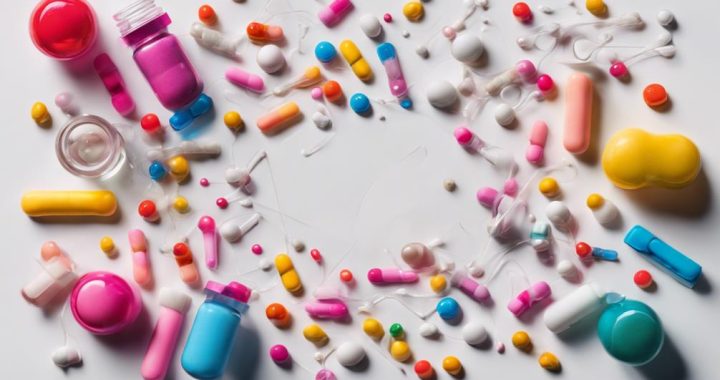Exploring the 7 best hormonal therapy options for sissy feminization? Consider estrogen therapy for female characteristics, anti-androgen treatment to suppress male hormones, and progesterone regimen for enhanced feminization. Combination hormone therapy combines estrogen and anti-androgens for best effects. GnRH agonist treatment decreases testosterone levels effectively. Utilize Finasteride to block testosterone conversion. Each option carries distinct benefits and risks, requiring consultation with healthcare providers for tailored plans.
Estrogen Therapy

Estrogen treatment is a common approach used in hormone replacement therapies for feminine change, with the aim of promoting the development of female secondary sexual characteristics. This treatment involves the administration of estrogen, typically through pills, patches, injections, or gels, to increase the levels of this primary female sex hormone in the body.
By replicating the hormonal environment found in individuals assigned female at birth, estrogen treatment can lead to changes such as breast development, redistribution of body fat to a more feminine pattern, softer skin, and a reduction in body hair growth.
Furthermore, estrogen treatment can also have psychological effects, potentially easing feelings of gender dysphoria and enhancing overall well-being. The dosage and method of administration are determined by healthcare providers based on individual needs and goals.
Regular monitoring of hormone levels and potential side effects is essential to guarantee the effectiveness and safety of estrogen treatment in the process of moving towards a more feminine appearance.
Anti-Androgen Treatment
In the process of sissy feminization, incorporating anti-androgen treatment can play an important role in suppressing the effects of male hormones to facilitate a more feminine transformation. Anti-androgens, also known as hormonal blockers, work by inhibiting the action of androgens, such as testosterone, in the body. By reducing the levels of these male hormones, anti-androgens help counteract masculine features and promote feminizing effects, such as breast development, softer skin, and reduced body hair growth.
Spironolactone and cyproterone acetate are common anti-androgens used in sissy feminization regimens. Spironolactone blocks the effects of testosterone by binding to androgen receptors, while cyproterone acetate not only inhibits androgen production but also has progestogenic properties. These medications are typically prescribed alongside estrogen therapy to achieve a more thorough feminizing effect.
Regular monitoring of hormone levels and potential side effects is important when undergoing anti-androgen treatment to guarantee the desired feminization outcomes while maintaining overall health.
Consulting with a healthcare provider specializing in transgender care can help individuals navigate the complexities of hormonal therapy for sissy feminization.
Progesterone Regimen
Utilizing a progesterone regimen as part of the sissy feminization process can contribute to enhancing feminizing effects by complementing the actions of estrogen therapy.
When considering a progesterone regimen, it's vital to determine the appropriate dosage for best results. Typical progesterone dosages for sissy feminization range from 100-200mg per day, either orally or through transdermal administration.
While progesterone is generally well-tolerated, some individuals may experience side effects. These can include mood changes, breast tenderness, bloating, and fatigue. It's crucial to monitor these side effects closely and consult with healthcare providers if they become bothersome or severe. Adjusting the dosage or changing the mode of administration may help alleviate these symptoms.
Incorporating progesterone into the feminization regimen should be done thoughtfully and with consideration of individual health factors.
Regular monitoring of hormone levels and overall health is necessary to ensure the progesterone regimen is effective and safe in achieving the desired feminizing effects.
Combination Hormone Therapy
Consider combining different hormone therapies to optimize the feminizing effects in your sissy transformation journey. Combination hormone therapy involves using a mix of estrogen and anti-androgens to achieve more significant changes in hormone levels compared to using each hormone type alone.
Estrogen helps develop feminine characteristics such as breast growth and softer skin, while anti-androgens reduce testosterone levels, further promoting a more feminine appearance.
When considering combination hormone therapy, it's important to monitor hormone levels regularly to verify they're within the desired range for feminization. This monitoring helps minimize the risk of potential side effects that can arise from imbalanced hormone levels.
Common side effects of combination hormone therapy may include mood swings, weight changes, and alterations in libido. By closely monitoring hormone levels and adjusting the therapy as needed, you can optimize the feminizing effects while minimizing the occurrence of side effects.
Consulting with a healthcare provider experienced in transgender care is essential to guarantee the safe and effective use of combination hormone therapy in your sissy feminization journey.
GnRH Agonist Treatment

Explore the efficacy of GnRH agonist treatment in enhancing the feminizing effects of hormone therapy for sissy feminization. GnRH agonists work by suppressing the production of testosterone, allowing for a more significant impact of estrogen in the body.
Studies have shown that combining GnRH agonists with estrogen therapy can lead to more pronounced feminization effects, such as breast development and softening of the skin.
In terms of effectiveness, GnRH agonist treatment has been found to be highly effective in reducing testosterone levels, which is vital for achieving the desired feminizing effects. However, it's important to note that individual responses may vary, and the effectiveness of the treatment can depend on various factors, such as dosage and treatment duration.
When pondering side effects, GnRH agonist treatment may present similar side effects to those of estrogen therapy, including hot flashes, mood changes, and decreased libido. Additionally, cost and accessibility can be factors to ponder, as GnRH agonists may be more expensive and require regular injections compared to other hormone therapy options.
It's imperative to consult with a healthcare provider to determine the most suitable treatment plan based on individual needs and goals.
Transdermal Patch Therapy
One effective method for administering hormone therapy in sissy feminization is through the use of transdermal patch therapy. Transdermal patches are applied to the skin, allowing for the gradual absorption of hormones into the bloodstream. This method offers several benefits for individuals seeking to feminize their appearance through hormone therapy.
Transdermal patch application provides a steady release of hormones, helping to maintain stable estrogen levels in the body. This consistent hormone absorption can lead to more predictable results compared to other methods.
Additionally, transdermal patches are easy to use and don't require daily administration, making them a convenient option for those undergoing sissy feminization.
Injectable Hormone Options

Injectable hormones, such as estradiol and testosterone, present a direct and efficient method for administering hormonal therapy in sissy feminization. When considering injectable options, understanding both the benefits and risks associated with this form of treatment is of utmost importance.
The primary benefit of injectable hormones is their rapid absorption into the bloodstream, leading to quicker and more consistent hormone levels compared to other delivery methods. However, the risks include potential injection site reactions, such as pain, swelling, or bruising.
In terms of frequency and dosage recommendations, the specifics can vary based on individual needs and hormone levels. Typically, estradiol injections are administered every one to two weeks, with dosages ranging from 5-20 mg per injection.
Testosterone injections, on the other hand, are usually given every 1-2 weeks for trans-feminine individuals at doses of 2.5-10 mg. It's essential to collaborate closely with a healthcare provider to determine the most appropriate injection schedule and dosage to achieve the desired feminization effects while minimizing potential risks.
Frequently Asked Questions
Can Hormonal Therapy for Sissy Feminization Be Reversed?
If you're considering hormonal therapy for sissy feminization, it's important to understand that some changes may be irreversible. Reversing these effects might be challenging, and discussing concerns with a healthcare provider is essential.
Are There Any Long-Term Health Risks Associated With These Treatments?
Hormonal therapy risks can include potential long-term health concerns. Monitoring by healthcare providers is essential to address any adverse effects. Stay informed, communicate openly with your medical team, and prioritize your well-being throughout the treatment process.
How Soon Can Visible Physical Changes Be Expected?
You can typically expect to see visible physical changes from hormonal therapy within a few months. These changes may vary depending on individual factors. Be patient and consistent with your treatment to see desired results.
Do These Therapies Affect Fertility or Reproductive Capabilities?
When considering hormonal therapy for sissy feminization, it's important to understand its impact on fertility and reproductive capabilities. These treatments can affect both, so consulting a healthcare provider for personalized guidance is essential.
Are There Specific Lifestyle Changes or Dietary Recommendations to Follow During Treatment?
To support hormone balance during treatment, consider adding nutrient-rich foods like leafy greens and lean proteins to your nutrition plan. Engage in regular exercise routines for overall well-being. Skincare tips may include gentle cleansing and moisturizing.
Conclusion
To sum up, the 7 best hormonal therapy options for sissy feminization offer a range of choices to help individuals achieve their desired feminine characteristics. From estrogen therapy to injectable hormone options, each treatment has its own benefits and considerations.
It's important to consult with a healthcare provider to determine the most suitable hormonal therapy regimen based on individual needs and goals. With proper guidance and monitoring, hormonal therapy can be a safe and effective way to support sissy feminization.
